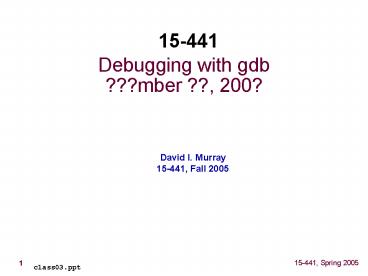Debugging with gdb ???mber ??, 200? - PowerPoint PPT Presentation
Title:
Debugging with gdb ???mber ??, 200?
Description:
Compile with '-g' (keep full symbol table) Don't use compiler optimization ('-O', ' O2' ... On a core (post-mortem) gdb progname core ... – PowerPoint PPT presentation
Number of Views:20
Avg rating:3.0/5.0
Title: Debugging with gdb ???mber ??, 200?
1
Debugging with gdb???mber ??, 200?
15-441
David I. Murray 15-441, Fall 2005
class03.ppt
2
Debugging with GDB
- Prepare program for debugging
- Compile with -g (keep full symbol table)
- Dont use compiler optimization (-O, O2, )
- Two main ways to run gdb
- On program directly
- gdb progname
- Once gdb is executing we can execute the program
with - run args
- Can use shell-style redirection e.g. run lt infile
gt /dev/null - On a core (post-mortem)
- gdb progname core
- Useful for examining program state at the point
of crash - Extensive in-program documentation exists
- help (or help lttopicgt or help ltcommandgt )
3
Controlling Your Program With GDB
- Stopping your program with breakpoints
- Program will run until it encounters a breakpoint
- To start running again cont
- Break command format
- break foo.c4 stops at the 4th source line of
foo.c - break 16 stops at the 16th source line of the
current source file - break main stops upon entry to the main()
function - Stop your program with SIGINT (CTRL-C)
- Useful if program hangs (sometimes)
- Stepping through your program
- step N command steps through N source lines
(default 1) - next is like step but it treats function calls as
a single line - Hint avoid writing mega-expressions
- Hard to step through foo(bar(tmp baz(), tmp2
baz2()))
4
Examining the State of Your Program
- backtrace ( bt for short)
- Shows stack trace (navigate procedures using up
and down) - bt full prints out all available local variables
as well - print EXP
- Print the value of expression
- Can print out values in variables
- x/ltcountgtltformatgtltsizegt ADDR
- Examine a memory region at ADDR
- Count is the number of items to display (default
1) - Format is a single letter code
- o(octal), x(hex), d(decimal), u(unsigned
decimal), t(binary), f(float), a(address),
i(instruction), c(char) and s(string) - Size is the size of the items (single letter
code) - b(byte), h(halfword), w(word), g(giant, 8 bytes)
5
Tips for the past
- Find a partner that doesnt procrastinate.
- Schedule a daily meeting time. DAILY.
- Do a couple hours of work each day.
- Even meeting 3 days a week for a few hours, my
partner and I pulled multiple all-nighters. Avoid
this by meeting daily. - Your implementations for each project can be
expected to be 5,000 lines of code, plus or minus
a few thousand (ours were between 4,000-6,000
lines). Divide that by days and its not as
daunting. - START THE DAY YOU RECEIVE THE PROJECT.
- My personal impression from last year is that the
majority of failed/mostly unsuccessful projects
failed due to time-related pressure, not
content/understanding material pressure - If you have time to do it, you can do it well. If
not
6
(No Transcript)
7
More tips for the past
- If you want to work directly on windows, you can
use MinGW or Cygwin, BUT TEST ON UNIX - http//www.mingw.org/
- http//www.cygwin.com/
- Most of the APIs you will use will have many
functions that return -1 to indicate error.
Unlike previous classes, you must be able to
recover when appropriate, and handle these errors
on a case-by-case basis. - Make buffers for each of your clients dont
process a command until you know youve received
the entire thing.
8
Finally
- These projects are about implementing
specifications. - Read the writeup at least twice before starting.
- PLAN on paper (even draw) BEFORE coding.
- PLAN, PLAN, PLAN.
- Then coding and debugging will be much easier,
and you wont have to delete hundreds of lines of
useless code over and over again. - Good luck!






























![FIN 200 Week 4 Quiz [4 Sets]/ UOP Homework/UOP tutorial PowerPoint PPT Presentation](https://s3.amazonaws.com/images.powershow.com/7603765.th0.jpg?_=20150507086)
